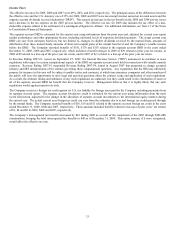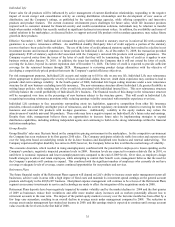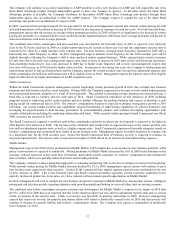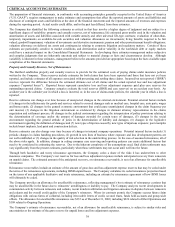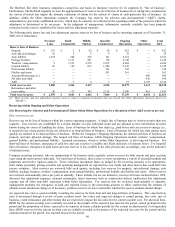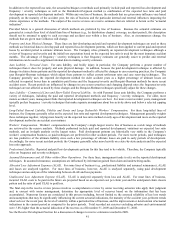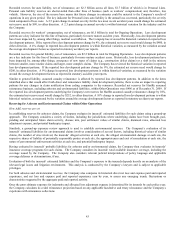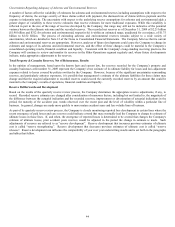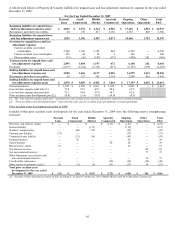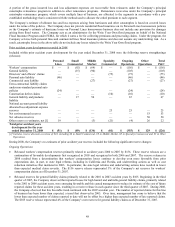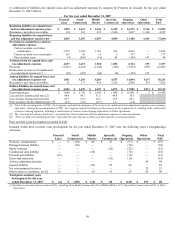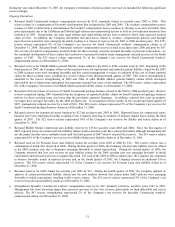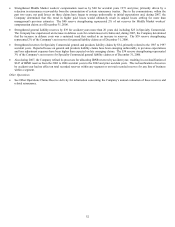The Hartford 2009 Annual Report Download - page 43
Download and view the complete annual report
Please find page 43 of the 2009 The Hartford annual report below. You can navigate through the pages in the report by either clicking on the pages listed below, or by using the keyword search tool below to find specific information within the annual report. 43
Recorded reserves for auto liability, net of reinsurance, are $2.3 billion across all lines, $1.7 billion of which is in Personal Lines.
Personal auto liability reserves are shorter-tailed than other lines of business (such as workers’ compensation) and, therefore, less
volatile. However, the size of the reserve base means that future changes in estimates could be material to the Company’ s results of
operations in any given period. The key indicator for Personal Lines auto liability is the annual loss cost trend, particularly the severity
trend component of loss costs. A 2.5 point change in annual severity for the two most recent accident years would change the estimated
net reserve need by $90, in either direction. A 2.5 point change in annual severity is within historical variation for the industry and for
the Company.
Recorded reserves for workers’ compensation, net of reinsurance, are $6.5 billion in total for Ongoing Operations. Loss development
patterns are a key indicator for this line of business, particularly for more mature accident years. Historically, loss development patterns
have been impacted by, among other things, medical cost inflation. The Company has reviewed the historical variation in reported loss
development patterns. If the reported loss development patterns change by 4%, the estimated net reserve need would change by $400, in
either direction. A 4% change in reported loss development patterns is within historical variation, as measured by the variation around
the average development factors as reported in statutory accident year reports.
Recorded reserves for general liability, net of reinsurance, are $2.2 billion in total for Ongoing Operations. Loss development patterns
are a key indicator for this line of business, particularly for more mature accident years. Historically, loss development patterns have
been impacted by, among other things, emergence of new types of claims (e.g., construction defect claims) or a shift in the mixture
between smaller, more routine claims and larger, more complex claims. The Company has reviewed the historical variation in reported
loss development patterns. If the reported loss development patterns change by 9%, the estimated net reserve need would change by
$200, in either direction. A 9% change in reported loss development patterns is within historical variation, as measured by the variation
around the average development factors as reported in statutory accident year reports.
Similar to general liability, assumed casualty reinsurance is affected by reported loss development patterns. In addition to the items
identified above that would affect both direct and reinsurance liability claim development patterns, there is also an impact to reporting
patterns for any changes in claim notification from ceding companies to the reinsurer. Recorded net reserves for HartRe assumed
reinsurance business, excluding asbestos and environmental liabilities, within Other Operations were $496 as of December 31, 2009. If
the reported loss development patterns underlying the Company's net reserves for HartRe assumed casualty reinsurance change by 10%,
the estimated net reserve need would change by $252, in either direction. A 10% change in reported loss development patterns is within
historical variation, as measured by the variation around the average development factors as reported in statutory accident year reports.
Reserving for Asbestos and Environmental Claims within Other Operations
How A&E reserves are set
In establishing reserves for asbestos claims, the Company evaluates its insureds’ estimated liabilities for such claims using a ground-up
approach. The Company considers a variety of factors, including the jurisdictions where underlying claims have been brought, past,
pending and anticipated future claim activity, disease mix, past settlement values of similar claims, dismissal rates, allocated loss
adjustment expense, and potential bankruptcy impact.
Similarly, a ground-up exposure review approach is used to establish environmental reserves. The Company’ s evaluation of its
insureds’ estimated liabilities for environmental claims involves consideration of several factors, including historical values of similar
claims, the number of sites involved, the insureds’ alleged activities at each site, the alleged environmental damage at each site, the
respective shares of liability of potentially responsible parties at each site, the appropriateness and cost of remediation at each site, the
nature of governmental enforcement activities at each site, and potential bankruptcy impact.
Having evaluated its insureds’ probable liabilities for asbestos and/or environmental claims, the Company then evaluates its insureds’
insurance coverage programs for such claims. The Company considers its insureds’ total available insurance coverage, including the
coverage issued by the Company. The Company also considers relevant judicial interpretations of policy language and applicable
coverage defenses or determinations, if any.
Evaluation of both the insureds’ estimated liabilities and the Company’ s exposure to the insureds depends heavily on an analysis of the
relevant legal issues and litigation environment. This analysis is conducted by the Company’ s lawyers and is subject to applicable
privileges.
For both asbestos and environmental reserves, the Company also compares its historical direct net loss and expense paid and reported
experience, and net loss and expense paid and reported experience year by year, to assess any emerging trends, fluctuations or
characteristics suggested by the aggregate paid and reported activity.
Once the gross ultimate exposure for indemnity and allocated loss adjustment expense is determined for its insureds by each policy year,
the Company calculates its ceded reinsurance projection based on any applicable facultative and treaty reinsurance and the Company’ s
experience with reinsurance collections.


